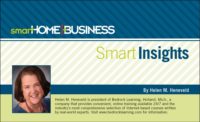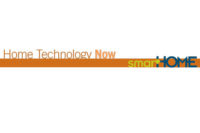Making market predictions is never an exact science, even for the experts. However, in the case of the baby boomers, with their sheer numbers, that they will dramatically affect a given consumer market is virtually guaranteed. “Other companies and industries have to pay for projections of the market. The Census Bureau tells us with precision that this segment of the market is growing,” says Stanley Oppenheim, president of Affiliated Monitoring, located in Union, N.J.
Forward-thinking dealers who are ready for this market boom have an unprecedented opportunity to expand their business opportunities while helping to improve the lives of aging Americans. More and more people will be looking for solutions to help them manage their changing needs, so they can remain in their own homes as long as possible. As this silver tsunami hits and places additional strain on limited health care resources, health care providers, insurance companies, and government agencies will be looking for ways to help them do so. “Keeping people in the home as long as possible is both serving the need of the individual senior and economically in the best interest of the nation,” Oppenheim believes.
When it comes to personal emergency response systems (PERS), basic alarm units and pendants have been available for decades to aid seniors in getting emergency help with the push of a button. Today PERS technology is becoming more sophisticated, available in pendant or watch options with two-way voice, fall sensors, and even GPS capability. Some units feature two buttons — one for emergency response and a second to put users in touch with a nurse who can answer questions and determine if additional help is needed. When it comes to products and services to help seniors stay in their homes longer, PERS is just the beginning.
Remaining active and independent requires more than access to help in an emergency. With age and illness, seniors have more difficulty completing activities of daily living (ADLs), such as getting out of bed, bathing, and eating. Various activity sensors can be used to monitor the senior’s actions. A pressure sensor in the bed can be used to determine whether someone gets out of bed or not, and how frequently. Pressure sensors in a floor mat next to the bed not only detect whether the senior has risen, but also can be used to trigger pathway lighting to the bathroom. Sensors placed on a refrigerator can indicate whether or not someone is eating. Motion sensors strategically positioned in a home can be set to trigger an alarm when no activity has been detected for an extended period of time. Cameras installed in the senior’s home can allow a caregiver to check on an elderly relative remotely. “As cameras in the home become more accepted, that’ll become a growing area as well,” says Vince Raia, president of EMC Security based in Suwanee, Ga.
Role of the Central Station
Many aging-in-place technologies, especially ADL monitoring, are not set up to contact a central station. Instead, when the system is activated, much like remote access options for security and home automation, an alert is sent via text, email, or tweet to a relative or neighbor. Alternatively, depending on the type of equipment and service, notifications may be sent to a central station, and the operator would notify either a designated contact on the call list or emergency services as needed.
Remembering to take medications at the right time and in the proper dose can be a challenge for many people. “The single biggest reason seniors go to the emergency room is medication non-compliance. For many seniors, overdosing or underdosing can be a situation of life or death,” warns Tom Ardolf, president of Cybermation, located in Waite Park, Minn. Several manufacturers provide medication dispensers that can be filled weekly or monthly. When a medication is due to be taken, an alarm sounds. The senior removes the dose of medication from its compartment and shuts off the alarm. If the medication is not taken in a timely manner, an alert will be sent to the monitoring station, and the operator will contact the senior or a caregiver.
Isolation and loneliness can also be serious problems for seniors. Some companies provide wellness calls as an optional service, in which the call center operator calls once a day or week to check in on the senior. “It really, to a large degree, allows the person to not feel isolated. Besides our call, they may not hear from anyone else they know that week,” says Christopher Baskin, CEO of American Two-Way, headquartered in North Hollywood, Calif. Technology also can play a role. Customizable, intuitive user interfaces like that offered by GrandCare Systems, allow seniors to use technology to play games, view photos, or communicate with friends and family via email or Skype.
Role of the Integrator
Internet connectivity has been an issue for older adults, limiting security and home automation options, as well as aging-in-place technology. However, that may be changing as adult caregivers look for ways to stay connected with their elderly relatives and the already Internet-savvy baby boomers age into the senior demographic.
“The integrator has a big role to play,” says Laura Mitchell, vice president, business development of West Bend, Wis.-based GrandCare Systems. “Internet connectivity is still an issue. That’s where they come into the picture.” Many products and services that support seniors, from lighting and home automation to socialization tools and telehealth devices, rely on an IP network within the home and Internet connectivity to reach beyond. Mitchell says that integrators, who are already comfortable programming IP devices, are the logical choice to deploy health care technology in the home. “Integrators are the perfect partners. We’re looking for individuals to put the pieces together to make customized solutions,” says Mitchell.
These solutions can help relatively healthy seniors age in place, but as health care costs grow and resources are stretched thin, the emerging technology in telehealth will become more widely used to help manage chronic conditions. Digital health solutions can be used to measure vital signs, including blood pressure, weight, glucose level, and pulse oxygen levels on a regular basis. The data can be saved for the physician or other health care provider to access as needed, or an alert can be sent when readings exceed a desired range.
From PERS and monitoring ADLs to digital health solutions for chronic conditions, a growing variety of technology is available to help individuals stay in their homes longer. Integrators who offer a range of options can become a comprehensive provider and be prepared to bring new components to the senior’s home as the person becomes frailer and in need of more services.
With a greater percentage of the population entering their golden years, the demand for PERS and other aging-in-place options is only going to increase. While the technology is available, the big question that remains is who will pay for it. At present, wealthier seniors have been able to purchase the devices and services to make their lives — and those of their caregivers — easier. With costs of hospitals, assisted-living facilities, and skilled nursing facilities skyrocketing, alternative solutions are becoming more appealing to insurance companies, government agencies, and senior service organizations looking for ways to cut expenses. Even if the individual can stay in the home for a week, it pays for the system, Mitchell says. “Big insurance providers have taken a huge interest. It’s not a matter of if, but when.”
As the payer issue is resolved, the industry will be able to fully embrace the surging demand. Integrators who make the effort to understand the market and the technology now will be better prepared to keep up with new developments in PERS and digital medicine that are just around the corner. By becoming an expert in this emerging market, they will be ready to take advantage of the many opportunities to increase their revenues while making a difference in the lives of their customers.
Mitchell emphasizes the time for integrators to educate themselves and secure their place in this industry is now, before the silver tsunami hits. “This is a market in its infancy. Once the rules of the game are clear, the window of opportunity is closed.”
Sidebar 1
Understand the Business
Providing home health solutions differs from traditional security. “It’s not simply adding another product in a line of products,” advises Stanley Oppenheim, president of Affiliated Monitoring, based in Union, N.J. Dealers need to be committed to understanding this unique market and create a new business model to succeed in this emergent industry. “They need to look at it as a separate part of the business and have the right personnel involved,” says Ralph Collier, PERS product manager for EMC Security, based in Suwanee, Ga.
Select the Right Monitoring Station
Finding a monitoring station that is knowledgeable and experienced with PERS is essential. PERS calls require specially trained operators who can work with a senior in distress, evaluate the situation, and coordinate the proper response, whether that is notifying a relative or dispatching emergency medical services. Calls are more frequent, longer in duration, and more labor-intensive. Because PERS monitoring is so intensive and interactive, integrators should be very careful in selecting a monitoring station that is aligned with the integrator’s business philosophy and approach to service.
Find the Right Partners
“It’s grassroots, finding who within your marketing area is in touch with your customers,” says Kevin O’Connor, president of Louisville, Ky.-based LogicMark. “Smaller, local companies have the advantage there, but they have to invest in personnel and resources.” Unlike traditional security, integrators offering aging-in-place solutions often do not directly approach the end users. Seniors and their relatives don’t look to security companies for questions about aging in place. They contact organizations, such as health care providers, assisted-living facilities, and employee-assistance programs, to learn more. By partnering with these groups, dealers can reach clients more effectively. “It takes a lot of legwork to get your name out there, but once you do, people will call,” says Jim Gleason, president of JNL Technologies, located in Ixonia, Wis.
Know Your Audience
When it comes to selling the technology to seniors, the integrator must understand the customers. Successful integrators are the ones who offer reliable, user-friendly products. “It’s a fine balance between technology and simplicity, especially with seniors,” O’Connor describes. The same applies to bundling services and products, which can be an effective strategy as long as the options are not too complicated.
While some seniors initially may be intimidated by technology, that does not have to be a barrier. Tom Ardolf of Cybermation says getting seniors to adopt the technology is a matter of making them comfortable. “I never take out a keyboard and a mouse when I deliver a system,” he says, pointing out that people will argue they don’t want a computer. “I deliver TVs. They just happen to be interactive TVs.” With the right products and approach, seniors are willing to embrace tools that make their lives easier. “Seniors train themselves for the technology…especially when nobody else is around,” Ardolf says.
Become a Resource
Dealers who succeed in this space understand that they have to do more than simply sell and install a product. “The ones who are successful are becoming the go-to person in home health care,” Mitchell acknowledges. Knowing what product works best for the client is key. “They’re the liaison to educate the family on options and can come off as an advocate and not just a salesperson,” she says.











